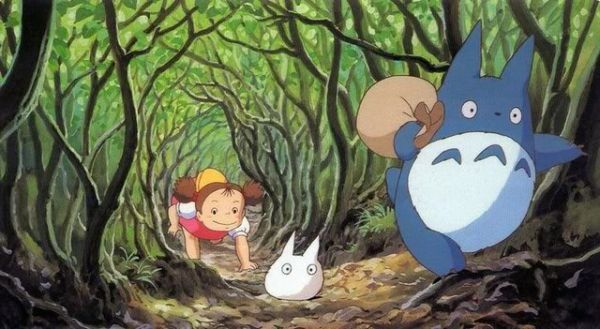Anime Movies - My Neighbor Totoro (Tonari no Totoro)
srijeda , 11.03.2015.I think it was about time for me to watch this anime classic. If nothing else, just to see what's all the hype about. I found the original 1988 version, but mine was dubbed. No matter, it was still fun to watch either way.
Looks like moving to the country was the best thing that could've happened to them. Those girls sure had bundles of fun exploring the new house and surrounding areas.Children's curiosity really is something special. There is no quitting when they find something that really truly peaks their interest.
In this case they got more than they bargained for. Way way more than anything they could've ever expected to stumble upon. That Totoro sure is something else. I'd be all over him like that kid. I just love huge soft and cuddly creatures. Don't know why, but this movie made me feel like a child again... simply amazing.
I'm really enjoy Studio Ghibli movies. They're always so full of emotions and life and most of all they are fun and project positivity. I must say that this studio is definitely making my favorite anime movies.
Plot
In 1958, the Kusakabe family reunites when a university professor and
his two daughters, Satsuki and Mei (approximately ten and four years
old, respectively) move into an old house in rural Japan to be closer to
the hospital where their mother is recovering from an unnamed,
long-term illness. The daughters find that the house is inhabited by
tiny animated dust creatures called susuwatari
— small, dark, dust-like house spirits seen when moving from light to
dark places. When the girls become comfortable in their new house and
laugh with their father, the soot spirits (identified as "black soots"
in early subtitles and "soot sprites" in the later English dubbed
version) leave the house to drift away on the wind. It is implied that
they are going to find another empty house--their natural habitat.
While she is playing outside one day, Mei sees two white, rabbit-like
ears in the grass. She follows the ears under the house where she
discovers two small magical creatures (chibi or "dwarf" totoro and chu or "medium" totoro), who lead her through a briar patch and into the hollow of a large camphor tree. She meets and befriends a larger version of the same kind of spirit (M or "large" totoro), which identifies itself by a series of roars that she interprets as "Totoro" (in the original Japanese dub, this stems from Mei's mispronunciation of the word for "troll"). She falls asleep atop the large totoro, but when Satsuki finds her, she
is on the ground in a dense briar clearing. Despite her many attempts,
Mei is unable to show her family Totoro's tree. Her father comforts her
by telling her that this is the "keeper of the forest," and that Totoro
will reveal himself when he wants to.
One rainy night, the girls are waiting for their father's bus and
grow worried when he does not arrive on the bus they expect him on. As
they wait, Mei eventually falls asleep on Satsuki's back and Totoro
appears beside them, allowing Satsuki to see him for the first time. He
only has a leaf on his head for protection against the rain, so Satsuki
offers him the umbrella she had taken along for her father. Totoro is
delighted at both the shelter and the sounds made upon it by falling
raindrops. In return, he gives her a bundle of nuts and seeds. A bus-shaped giant cat halts at the stop, and Totoro boards it, taking the umbrella. Shortly after, their father’s bus arrives.
The girls plant the seeds. A few days later, they awaken at midnight
to find Totoro and his two miniature colleagues engaged in a ceremonial dance
around the planted nuts and seeds. The girls join in, whereupon the
seeds sprout, and then grow and combine into an enormous tree. Totoro
takes his colleagues and the girls for a ride on a magical flying top. In the morning, the tree is gone, but the seeds have indeed sprouted.
The girls find out that a planned visit by their mother has to be
postponed because of a setback in her treatment. Satsuki takes this very
hard, having reached the age where she fully understands the concept of
death. Frustrated and frightened, she yells at Mei, then stomps away.
Mei, believing that her mother can be cured by healthy food, sets off on
foot to the hospital with an ear of corn.
Mei's disappearance prompts Satsuki and the neighbors to search for her. Eventually, Satsuki returns in desperation to the camphor tree
and pleads for Totoro's help. Delighted to be of assistance, he summons
the Catbus, which carries her to where the lost Mei sits. Having
rescued her, the Catbus then whisks her and Satsuki over the countryside
to see their mother in the hospital. The girls perch in a tree outside
of the hospital, overhearing a conversation between their parents and
discovering that she has been kept in hospital by a minor cold and is
otherwise doing well. They secretly leave the ear of corn on the
windowsill, where it is discovered by the parents, and return home on
the Catbus. When the Catbus departs, it fades away from the girls'
sight.
The closing credits show Mei and Satsuki's mother returning home and
feature scenes of Satsuki and Mei playing with other children, with
Totoro and his friends as unseen observers.
Director: Hayao Miyazaki
Writer: Hayao Miyazaki
Music: Joe Hisaishi
Distributor: Toho
Release Date: April 16, 1988
Running time: 86 minutes
Country: Japan
Language: Japanese
komentiraj (0) * ispiši * #




